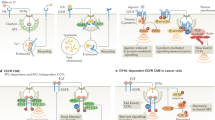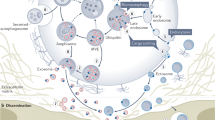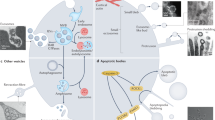Abstract
The plasma membrane is the interface between cells and their harsh environment. Uptake of nutrients and all communication among cells and between cells and their environment occurs through this interface. ‘Endocytosis’ encompasses several diverse mechanisms by which cells internalize macromolecules and particles into transport vesicles derived from the plasma membrane. It controls entry into the cell and has a crucial role in development, the immune response, neurotransmission, intercellular communication, signal transduction, and cellular and organismal homeostasis. As the complexity of molecular interactions governing endocytosis are revealed, it has become increasingly clear that it is tightly coordinated and coupled with overall cell physiology and thus, must be viewed in a broader context than simple vesicular trafficking.
This is a preview of subscription content, access via your institution
Access options
Subscribe to this journal
Receive 51 print issues and online access
$199.00 per year
only $3.90 per issue
Buy this article
- Purchase on Springer Link
- Instant access to full article PDF
Prices may be subject to local taxes which are calculated during checkout




Similar content being viewed by others
References
De Duve, C. Blueprint for a Cell: The Nature and Origin of Life (Patterson, Burlington, North Carolina, 1991)
Aderem, A. & Underhill, D. M. Mechanisms of phagocytosis in macrophages. Annu. Rev. Immunol. 17, 593–623 (1999)
Hall, A. & Nobes, C. D. Rho GTPases: Molecular switches that control the organization and dynamics of the actin cytoskeleton. Phil. Trans. R. Soc. Lond. B 355, 965–970 (2000)
Fadok, V. A. & Chimini, G. The phagocytosis of apoptotic cells. Semin. Immunol. 13, 365–372 (2001)
Gold, E. S. et al. Dynamin 2 is required for phagocytosis in macrophages. J. Exp. Med. 190, 1849–1856 (1999)
Steele-Mortimer, O., Knodler, L. A. & Finlay, B. B. Poisons, ruffles and rockets: Bacterial pathogens and the host cell cytoskeleton. Traffic 1, 107–118 (2000)
Chimini, G. & Chavrier, P. Function of Rho family proteins in actin dynamics during phagocytosis and engulfment. Nature Cell Biol. 2, E191–E196 (2000)
Ridley, A. J. Rho proteins: Linking signaling with membrane trafficking. Traffic 2, 303–310 (2001)
Mellman, I. & Steinman, R. M. Dendritic cells: Specialized and regulated antigen processing machines. Cell 106, 255–258 (2001)
Anderson, R. G. The caveolae membrane system. Annu. Rev. Biochem. 67, 199–225 (1998)
Drab, M. et al. Loss of caveolae, vascular dysfunction, and pulmonary defects in caveolin-1 gene-disrupted mice. Science 293, 2449–2452 (2001)
Razani, B., Woodman, S. E. & Lisanti, M. P. Caveolae: From cell biology to animal physiology. Pharmacol. Rev. 54, 431–467 (2002)
Pelkmans, L., Puntener, D. & Helenius, A. Local actin polymerization and dynamin recruitment in SV40-induced internalization of caveolae. Science 296, 535–539 (2002)
Thomsen, P., Roepstorff, K., Stahlhut, M. & van Deurs, B. Caveolae are highly immobile plasma membrane microdomains, which are not involved in constitutive endocytic trafficking. Mol. Biol. Cell 13, 238–250 (2002)
Pelkmans, L. & Helenius, A. Endocytosis via caveolae. Traffic 3, 311–320 (2002)
Parton, R. G., Joggerst, B. & Simons, K. Regulated internalization of caveolae. J. Cell Biol. 127, 1199–1215 (1994)
Minshall, R. D. et al. Endothelial cell-surface gp60 activates vesicle formation and trafficking via Gi-coupled Src kinase signaling pathway. J. Cell Biol. 150, 1057–1070 (2000)
Le, P. U., Guay, G., Altschuler, Y. & Nabi, I. R. Caveolin-1 is a negative regulator of caveolae-mediated endocytosis to the endoplasmic reticulum. J. Biol. Chem. 277, 3371–3379 (2002)
Edidin, M. Shrinking patches and slippery rafts: Scales of domains in the plasma membrane. Trends Cell Biol. 11, 492–496 (2001)
Anderson, R. G. & Jacobson, K. A role for lipid shells in targeting proteins to caveolae, rafts, and other lipid domains. Science 296, 1821–1825 (2002)
Sandvig, K., Olsnes, S., Brown, J. E., Petersen, O. W. & van Deurs, B. Endocytosis from coated pits of Shiga toxin: A glycolipid-binding protein from Shigella dysenteriae 1. J. Cell Biol. 108, 1331–1343 (1989)
Lamaze, C. et al. Interleukin 2 receptors and detergent-resistant membrane domains define a clathrin-independent endocytic pathway. Mol. Cell 7, 661–671 (2001)
Nichols, B. J. & Lippincott-Schwartz, J. Endocytosis without clathrin coats. Trends Cell Biol. 11, 406–412 (2001)
Artalejo, C. R., Elhamdani, A. & Palfrey, H. C. Sustained stimulation shifts the mechanism of endocytosis from dynamin-1-dependent rapid endocytosis to clathrin- and dynamin-2-mediated slow endocytosis in chromaffin cells. Proc. Natl Acad. Sci. USA 99, 6358–6363 (2002)
Damke, H., Baba, T., van der Bliek, A. M. & Schmid, S. L. Clathrin-independent pinocytosis is induced in cells overexpressing a temperature-sensitive mutant of dynamin. J. Cell Biol. 131, 69–80 (1995)
Schmid, S. L. Clathrin-coated vesicle formation and protein sorting: An integrated process. Annu. Rev. Biochem. 66, 511–548 (1997)
Brodsky, F. M., Chen, C.-Y., Kneuhl, C., Towler, M. C. & Wakeham, D. E. Biological basket weaving: Formation and function of clathrin-coated vesicles. Annu. Rev. Cell Dev. Biol. 17, 517–568 (2001)
Di Fiore, P. P. & De Camilli, P. Endocytosis and signaling: An inseparable partnership. Cell 106, 1–4 (2001)
Seto, E. S., Bellen, H. J. & Lloyd, T. E. When cell biology meets development: Endocytic regulation of signaling pathways. Genes Dev. 16, 1314–1336 (2002)
Beattie, E. C. et al. Regulation of AMPA receptor endocytosis by a signaling mechanism shared with LTD. Nature Neurosci. 3, 1291–1300 (2000)
De Camilli, P. & Takei, K. Molecular mechanisms in synaptic vesicle endocytosis and recycling. Neuron 16, 481–486 (1996)
Kirchhausen, T. Clathrin. Annu. Rev. Biochem. 69, 699–727 (2000)
Kirchhausen, T. Adaptors for clathrin-mediated traffic. Annu. Rev. Cell Dev. Biol. 15, 705–732 (1999)
Robinson, M. S. & Bonifacino, J. S. Adaptor-related proteins. Curr. Opin. Cell Biol. 13, 444–453 (2001)
Collins, B. M., McCoy, A. J., Kent, H. M., Evans, P. R. & Owen, D. J. Molecular architecture and functional model of the endocytic AP2 complex. Cell 109, 523–535 (2002)
Marsh, M. & McMahon, H. T. The structural era of endocytosis. Science 285, 215–220 (1999)
Lindner, R. & Ungewickell, E. Clathrin-associated proteins of bovine brain coated vesicles. J. Biol. Chem. 267, 16567–16573 (1992)
McMahon, H. T. Endocytosis: An assembly protein for clathrin cages. Curr. Biol. 9, R332–R335 (1999)
Wendland, B. & Emr, S. D. Pan1p, yeast eps15, functions as a multivalent adaptor that coordinates protein-protein interactions essential for endocytosis. J. Cell Biol. 141, 71–84 (1998)
Tebar, F., Bohlander, S. K. & Sorkin, A. Clathrin assembly lymphoid myeloid leukemia (CALM) protein: Localization in endocytic-coated pits, interactions with clathrin, and the impact of overexpression on clathrin-mediated traffic. Mol. Biol. Cell 10, 2687–2702 (1999)
Springer, S., Spang, A. & Schekman, R. A primer on vesicle budding. Cell 97, 145–148 (1999)
Rothman, J. E. The machinery and principles of vesicle transport in the cell. Nature Med. 8, 1059–1062 (2002)
Lin, H. C., Moore, M. S., Sanan, D. A. & Anderson, R. G. W. Reconstitution of clathrin-coated pit budding from plasma membranes. J. Cell Biol. 114, 881–891 (1991)
Smythe, E., Carter, L. L. & Schmid, S. L. Cytosol- and clathrin-dependent stimulation of endocytosis in vitro by purified adaptors. J. Cell Biol. 119, 1163–1171 (1992)
Gilbert, A., Paccaud, J. P. & Carpentier, J. L. Direct measurement of clathrin-coated vesicle formation using a cell-free assay. J. Cell Sci. 110, 3105–3115 (1997)
Hinshaw, J. E. Dynamin and its role in membrane fission. Annu. Rev. Cell Dev. Biol. 16, 483–519 (2000)
Sever, S., Damke, H. & Schmid, S. L. Garrotes, springs, ratchets and whips: Putting dynamin models to the test. Traffic 1, 385–392 (2000)
Hinshaw, J. E. & Schmid, S. L. Dynamin self assembles into rings suggesting a mechanism for coated vesicle budding. Nature 374, 190–192 (1995)
Sweitzer, S. & Hinshaw, J. Dynamin undergoes a GTP-dependent conformational change causing vesiculation. Cell 93, 1021–1029 (1998)
Stowell, M. H. B., Marks, B., Wigge, P. & McMahon, H. T. Nucleotide-dependent conformational changes in dynamin: Evidence for a mechanochemical molecular spring. Nature Cell Biol. 1, 27–32 (1999)
Sever, S., Muhlberg, A. B. & Schmid, S. L. Impairment of dynamin's GAP domain stimulates receptor-mediated endocytosis. Nature 398, 481–486 (1999)
Song, B. D. & Schmid, S. L. A Molecular motor or a regulator? Dynamin's in a class of its own. Biochemistry 42, 1369–1376 (2003)
Damke, H., Baba, T., Warnock, D. E. & Schmid, S. L. Induction of mutant dynamin specifically blocks endocytic coated vesicle formation. J. Cell Biol. 127, 915–934 (1994)
Damke, H., Binns, D. D., Ueda, H., Schmid, S. L. & Baba, T. Dynamin GTPase domain mutants block endocytic vesicle formation at morphologically distinct stages. Mol. Biol. Cell 12, 2578–2589 (2001)
Marks, B. et al. GTPase activity of dynamin and resulting conformation change are essential for endocytosis. Nature 410, 231–235 (2001)
Sever, S., Damke, H. & Schmid, S. L. Dynamin:GTP controls the formation of constricted coated pits, the rate limiting step in clathrin-mediated endocytosis. J. Cell Biol. 150, 1137–1148 (2000)
Rothman, J. E. Mechanisms of intracellular protein transport. Nature 372, 55–63 (1994)
Slepnev, V. I. & De Camilli, P. Accessory factors in clathrin-dependent synaptic vesicle endocytosis. Nature Rev. Neurosci. 1, 161–172 (2000)
Farsad, K. et al. Generation of high curvature membranes mediated by direct endophilin bilayer interactions. J. Cell Biol. 155, 193–200 (2001)
Takei, K. et al. Generation of coated intermediates of clathrin-mediated endocytosis on protein-free liposomes. Cell 94, 131–141 (1998)
Ford, M. G. et al. Simultaneous binding of PtdIns(4,5)P2 and clathrin by AP180 in the nucleation of clathrin lattices on membranes. Science 291, 1051–1055 (2001)
Gaidarov, I., Santini, F., Warren, R. A. & Keen, J. H. Spatial control of coated pit dynamics in living cells. Nature Cell Biol. 1, 1–7 (1999)
Roos, J. & Kelly, R. B. The endocytic machinery in nerve terminals surrounds sites of exocytosis. Curr. Biol. 9, 1411–1414 (1999)
Wigge, P. & McMahon, H. T. The amphiphysin family of proteins and their role in endocytosis at the synapse. Trends Neurosci. 21, 339–344 (1998)
Zhang, B. & Zelhof, A. C. Amphiphysins: Raising the BAR for synaptic vesicle recycling and membrane dynamics. Traffic 3, 452–460 (2002)
Benmerah, A., Bayrou, M., Cerf-Bensussan, N. & Dautry-Varsat, A. Inhibition of clathrin-coated pit assembly by an Eps15 mutant. J. Cell Sci. 112, 1303–1311 (1999)
Confalonieri, S., Salcini, A. E., Puri, C., Tacchetti, C. & Di Fiore, P. P. Tyrosine phosphorylation of Eps15 is required for ligand-regulated, but not constitutive, endocytosis. J. Cell Biol. 150, 905–912 (2000)
Ford, M. G. et al. Curvature of clathrin-coated pits driven by epsin. Nature 419, 361–366 (2002)
Hyman, J., Chen, H., Di Fiore, P. P., De Camilli, P. & Brunger, A. T. Epsin 1 undergoes nucleocytosolic shuttling and its eps15 interactor NH2-terminal homology (ENTH) domain, structurally similar to Armadillo and HEAT repeats, interacts with the transcription factor promyelocytic leukemia Zn2+ finger protein (PLZF). J. Cell Biol. 149, 537–546 (2000)
Doria, M. et al. The eps15 homology (EH) domain-based interaction between eps15 and hrb connects the molecular machinery of endocytosis to that of nucleocytosolic transport. J. Cell Biol. 147, 1379–1384 (1999)
Yamabhai, M. et al. Intersectin, a novel adaptor protein with two Eps15 homology and five Src homology 3 domains. J. Biol. Chem. 273, 31401–31407 (1998)
McPherson, P. S., Kay, B. K. & Hussain, N. K. Signaling on the endocytic pathway. Traffic 2, 375–384 (2001)
Cremona, O. & De Camilli, P. Phosphoinositides in membrane traffic at the synapse. J. Cell Sci. 114, 1041–1052 (2001)
Takei, K., Slepnev, V. I., Haucke, V. & De Camilli, P. Functional partnership between amphiphysin and dynamin in clathrin-mediated endocytosis. Nature Cell Biol. 1, 33–39 (1999)
Burger, K. N., Demel, R. A., Schmid, S. L. & de Kruijff, B. Dynamin is membrane-active: Lipid insertion is induced by phosphoinositides and phosphatidic acid. Biochemistry 39, 12485–12493 (2000)
Schmidt, A. et al. Endophilin I mediates synaptic vesicle formation by transfer of arachidonate to lysophosphatidic acid. Nature 401, 133–141 (1999)
Ayscough, K. R. Endocytosis and the development of cell polarity in yeast require a dynamic F-actin cytoskeleton. Curr. Biol. 10, 1587–1590 (2000)
Fujimoto, L. M., Roth, R., Heuser, J. E. & Schmid, S. L. Actin assembly plays a variable, but not obligatory role in receptor-mediated endocytosis in mammalian cells. Traffic 1, 161–171 (2000)
Qualmann, B., Kessels, M. M. & Kelly, R. B. Molecular links between endocytosis and the actin cytoskeleton. J. Cell Biol. 150, F111–F116 (2000)
Merrifield, C. J. et al. Endocytic vesicles move at the tips of actin tails in cultured mast cells. Nature Cell Biol. 1, 72–74 (1999)
Merrifield, C., Feldman, M. E., Wan, L. & Almers, W. Imaging actin and dynamin recruitment during invagination of single clathrin-coated pits. Nature Cell Biol. 4, 691–698 (2002)
Lee, E. & De Camilli, P. Dynamin at actin tails. Proc. Natl Acad. Sci. USA 99, 161–166 (2002)
Orth, J. D., Krueger, E. W., Cao, H. & McNiven, M. A. The large GTPase dynamin regulates actin comet formation and movement in living cells. Proc. Natl Acad. Sci. USA 99, 167–172 (2002)
Cousin, M. A. & Robinson, P. J. The dephosphins: Dephosphorylation by calcineurin triggers synaptic vesicle endocytosis. Trends Neurosci. 24, 659–665 (2001)
Wilde, A. & Brodsky, F. M. In vivo phosphorylation of adaptors regulates their interaction with clathrin. J. Cell Biol. 135, 635–646 (1996)
Fingerhut, A., von Figura, K. & Honing, S. Binding of AP2 to sorting signals is modulated by AP2 phosphorylation. J. Biol. Chem. 276, 5476–5482 (2001)
Olusanya, O., Andrews, P. D., Swedlow, J. R. & Smythe, E. Phosphorylation of threonine 156 of the µ2 subunit of the AP2 complex is essential for endocytosis in vitro and in vivo. Curr. Biol. 11, 896–900 (2001)
Greener, T., Zhao, X., Nojima, H., Eisenberg, E. & Greene, L. E. Role of cyclin G-associated kinase in uncoating clathrin-coated vesicles from non-neuronal cells. J. Biol. Chem. 275, 1365–1370 (2000)
Korolchuk, V. I. & Banting, G. CK2 and GAK/auxilin2 are major protein kinases in clathrin-coated vesicles. Traffic 3, 428–439 (2002)
Conner, S. D. & Schmid, S. L. Identification of an adaptor-associated kinase, AAK1, as a regulator of clathrin-mediated endocytosis. J. Cell Biol. 156, 921–929 (2002)
Ricotta, D., Conner, S. D., Schmid, S. L., von Figura, K. & Honing, S. Phosphorylation of the AP2 µ subunit by AAK1 mediates high affinity binding to membrane protein sorting signals. J. Cell Biol. 156, 791–795 (2002)
Warren, R. A., Green, F. A., Stenberg, P. E. & Enns, C. A. Distinct saturable pathways for the endocytosis of different tyrosine motifs. J. Biol. Chem. 273, 17056–17063 (1998)
Morris, S. M. & Cooper, J. A. Disabled-2 colocalizes with the LDLR in clathrin-coated pits and interacts with AP-2. Traffic 2, 111–123 (2001)
Mishra, S. K. et al. Disabled-2 exhibits the properties of a cargo-selective endocytic clathrin adaptor. EMBO J. 21, 4915–4926 (2002)
Miller, W. E. & Lefkowitz, R. J. Expanding roles for β-arrestins as scaffolds and adapters in GPCR signaling and trafficking. Curr. Opin. Cell Biol. 13, 139–145 (2001)
Hicke, L. A new ticket for entry into budding vesicles—ubiquitin. Cell 106, 527–530 (2001)
Wilde, A. et al. EGF receptor signaling stimulates SRC kinase phosphorylation of clathrin, influencing clathrin redistribution and EGF uptake. Cell 96, 677–687 (1999)
Ahn, S. et al. Src-dependent tyrosine phosphorylation regulates dynamin self-assembly and ligand-induced endocytosis of the epidermal growth factor receptor. J. Biol. Chem. 277, 26642–26651 (2002)
Acknowledgements
We thank R. Milligan, M. G. Finn and C. Waterman-Storer for critically reading the manuscript, and acknowledge the many researchers whose important contributions to the primary literature can be found in the reviews that were cited owing to space limitations.
Author information
Authors and Affiliations
Corresponding author
Rights and permissions
About this article
Cite this article
Conner, S., Schmid, S. Regulated portals of entry into the cell. Nature 422, 37–44 (2003). https://doi.org/10.1038/nature01451
Issue Date:
DOI: https://doi.org/10.1038/nature01451
This article is cited by
-
Synthesis and biophysical evaluation of carbosilane dendrimers as therapeutic siRNA carriers
Scientific Reports (2024)
-
Transferrin modified PEG–PLGA nanoparticles: highly effective notoginsenoside R1 formulations for the treatment of ulcerative colitis
Journal of Pharmaceutical Investigation (2024)
-
HIV infection of non-classical cells in the brain
Retrovirology (2023)
-
A review of the regulatory mechanisms of extracellular vesicles-mediated intercellular communication
Cell Communication and Signaling (2023)
-
Self-assembled lipid–prodrug nanoparticles
Nature Reviews Bioengineering (2023)
Comments
By submitting a comment you agree to abide by our Terms and Community Guidelines. If you find something abusive or that does not comply with our terms or guidelines please flag it as inappropriate.



